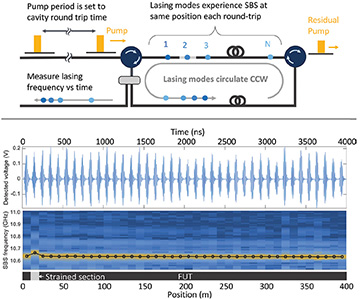 Top: Principle of distributed Brillouin fiber laser sensor. Bottom: Interference signal produced by Brillouin lasing modes, and spectrogram showing a frequency shift at the strained section of fiber. [Enlarge figure]
Top: Principle of distributed Brillouin fiber laser sensor. Bottom: Interference signal produced by Brillouin lasing modes, and spectrogram showing a frequency shift at the strained section of fiber. [Enlarge figure]
Distributed fiber sensors can monitor temperature and strain at thousands of locations and across long distances using a single optical fiber. These features have led to the adoption of fiber sensors in applications as varied as structural-health monitoring and seismic detection. Many of the most successful fiber sensors rely on Brillouin scattering, which enables absolute measurements of temperature or strain in standard telecom fiber with cm-scale resolution over distances of approximately 100 km.1 This conventional sensor design operates by measuring the Brillouin resonance frequency, which scales with temperature and strain.
Traditionally, Brillouin fiber sensors fall into two categories. Those based on spontaneous Brillouin scattering (SpBS) operate by injecting a pump beam into the sensing fiber and measuring the frequency of Brillouin backscattered light. This protocol enables a wide dynamic range, but low light levels result in poor sensitivity. The other type of system, based on stimulated Brillouin scattering (SBS), measures the interaction between a pump beam and a counter-propagating probe beam. This provides a more accurate measurement of the Brillouin resonance, but the dynamic range is limited by the need to scan the probe frequency. Historically, this has introduced a trade-off between sensitivity and dynamic range that has limited the application space for Brillouin sensors.
In work published this year, we introduced a new sensing methodology that uses Brillouin lasing to overcome this trade-off.2,3 Our scheme is based on a cavity designed to support a series of modes that lase at the Brillouin resonant frequency at discrete locations in the sensing fiber. As such, this technique can provide wide dynamic range by foregoing the scanned probe beam, while the high intensity and linewidth narrowing associated with the lasing transition can enable high sensitivity.
We constructed a fiber ring cavity and introduced a pulsed pump at a repetition period matching the cavity round-trip time. This excited a series of lasing modes which experienced Brillouin amplification at the same position in the fiber after each round-trip. Since the modes were pulsed, they lased at the peak of the Brillouin gain spectrum, rather than a cavity mode.
By recording the frequency of these lasing modes, we were able to monitor the Brillouin resonance at each location along the fiber.2 Ultimately, we demonstrated the scalability of this approach by exciting 1,000 lasing modes—and thereby enabling 1,000 sensing positions—along a 3.5-km fiber, while maintaining strain noise as low as 34 nε/Hz½ and a dynamic range of 4 mε.3 We believe that our approach—which combines the sensitivity of state-of-the-art SBS-based sensors with the dynamic range of SpBS-based systems—could enable a new range of applications for this class of fiber sensor.
Researchers
Joseph B. Murray and Brandon Redding, US Naval Research Laboratory, Washington, DC, USA
Alex Cerjan, Center for Integrated Nanotechnologies, Sandia National Laboratories, Albuquerque, NM, USA
References
1. A. Motil et al. Opt. Laser Technol. 78, 81 (2016).
2. J. Murray et al. Optica 9, 80 (2022).
3. J. Murray et al. Opt. Express 30, 25765 (2022).
